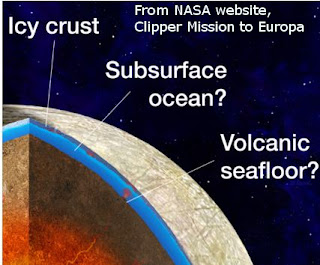The Mission to Jupiter’s Moon Europa (Clipper)
Some time back (2017), I blogged about NASA’s upcoming
decision about a possible mission to Jupiter’s moon Europa. You can check out that blog with the link
below, which also has a lot of general information about Europa.
Europa is one of the preferred targets for the search for
non-Earth life within the solar system, as there is every indication of a
watery ocean below a permanent layer of ice, though we don’t yet know how thick
the ice actually is. The possibility of
there being such an ocean was noted from results of the Voyager missions, during
the last century. Since then, the
evidence for ice and water has only grown stronger (e.g. images and
measurements from other probes, Hubble photos that seem to have spotted water
plumes being thrown high above the surface, etc.).
That’s important, as NASA has a “follow the water” strategy,
in its search for life. The tidal
disruptions that keep the moon’s ocean from freezing may also provide energy
for life, and the chemicals that may be found at the ocean/crust boundary might
provide the needed raw materials for life.
The ultimate mission would include a lander, and some sort
of vehicle to access that ocean beneath the ice, to search for signs of life
directly. Although that mission is still some time in the future, it seems as
if a preliminary mission, a series of close encounters with Europa called “Clipper”
is moving ahead to the next stage (as many as 45 flybys, one every couple of
weeks). The mission is scheduled for
sometime in the 2020s.
The Clipper mission will carry out detailed reconnaissance
of Europa, via a number of close fly-bys of the moon. It will have an eccentric orbit around
Jupiter, which will allow it to remain a safe distance from Jupiter’s intense
magnetic field for much of the time.
That’s important, as the magnetic field traps highly charged and highly
energetic particles from the solar wind, which are destructive to highly sensitive
instruments, such as Clipper will carry.
Then, once each orbit, the spacecraft will swoop down towards Europa, on
a fast and close flyby, and collect close-in scientific data.
The probe will carry a number of scientific instruments,
including:
- High resolution cameras, to take very detailed pictures of the surface, including “chaotic” features which may actually be where water has broken through the ice in the fairly recent past.
- Spectrometers, which will help to determine the composition of the surface, by measuring the tenuous atmosphere and/or particles there, as well as the spectra of light coming from the surface.
- A Dust Analyser, to investigate the properties of dust that may be in the high atmosphere of Europa, presumably ejected by the moon.
- Ice penetrating radar, to estimate the depth of the ice (i.e. the distance to the under-ice ocean).
- Magnetometers, to measure the strength and direction of Europa’s magnetic field in detail, which will also help discover important facts about the ocean, such as its level of salinity (salt in the water acts as an electrical conductor, which induces a magnetic field).
- A Thermal Instrument (ultra-sophisticated infra-red camera?) to identify warm spots on the ice, where the water has “outcropped” in the recent past, or is still escaping to the surface. If plumes are detected, it may be possible to sample them directly, and gain information about the under-ice ocean.
At this stage of the process, NASA has selected a number of
research teams to propose and build the scientific payload described above
(possibly other instruments as well).
After that (assuming the necessary funding is given) the instrumentation
will be finalized and built and the details of the mission’s launch, flight
path, orbit, etc. will be worked out.
Then, the mission itself (2020s), hopefully followed by the
proposed Europa Lander mission, a few years later (2030s).
Sources:
1 – Proposed Europa Mission, from 2017
2 – Facts about Europa
3 – NASA site, regarding the Clipper mission
-----------------------------------------------------------------------------------------------------------------
Now that you have read some real science (astronomy and astrophysics), you should read some science fiction. The Witch’s Stones series would be an excellent choice. Alternatively, you could try the short story “The Magnetic Anomaly”, a SF story which includes plenty of interesting geophysics, including magnetic fields.
Now that you have read some real science (astronomy and astrophysics), you should read some science fiction. The Witch’s Stones series would be an excellent choice. Alternatively, you could try the short story “The Magnetic Anomaly”, a SF story which includes plenty of interesting geophysics, including magnetic fields.
The Witches’ Stones
You might prefer, the trilogy of the Witches’ Stones (they’re psychic aliens, not actual witches), which follows the interactions of a future Earth confederation, an opposing galactic power, and the Witches of Kordea. It features Sarah Mackenzie, another feisty young Earth woman (they’re the most interesting type – the novelist who wrote the books is pretty feisty, too).The Magnetic Anomaly: A Science Fiction Story
“A geophysical crew went into the Canadian north. There were
some regrettable accidents among a few ex-military who had become geophysical
contractors after their service in the forces. A young man and young woman went
temporarily mad from the stress of seeing that. They imagined things, terrible
things. But both are known to have vivid imaginations; we have childhood
records to verify that. It was all very sad. That’s the official story.”





No comments:
Post a Comment